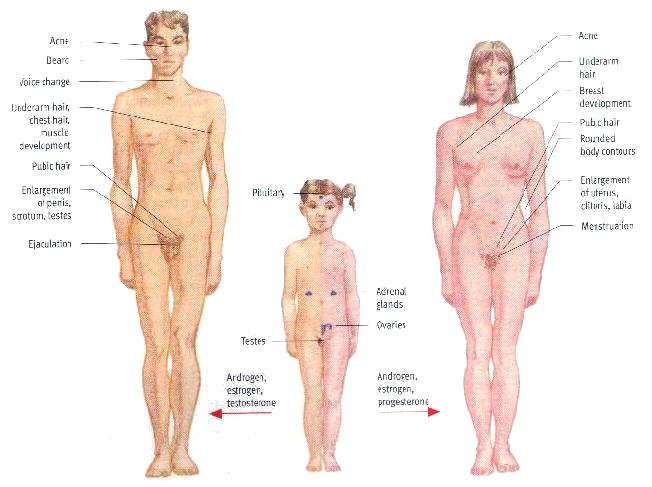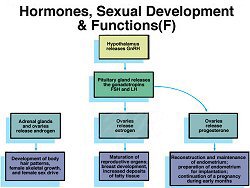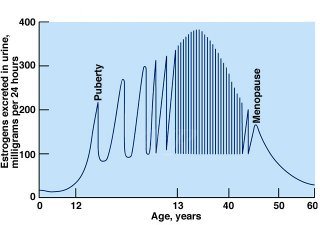
Puberty in Adolescents: Transsexuality
Additional chapters in This Section include:
Gender Reassignment Surgery
Orchiectomy for MTF Transsexual Women
FFS Facial Feminization Surgery
MTF Transsexual Surgeries
Hormone Replacement Therapy for Transgender Women
Female Hormone Therapy MTF Transsexuals
Breast Development in MTF Transsexuals
MTF Transsexual Breast Enlargement
Breast Augmentation MTF Transsexuals
Lactation and the Transsexual Woman
Injecting Silicone for Transsexual Women
Brazilian Hips and Buttock Enlargement
Average Body Size MTF Transgender
Male and Female Skeleton Transsexuals
Treatment of Young Transsexuals
Puberty in Adolescents MTF Transgender
Treatment of Young MTF Transsexuals
Treatment of Intersex Infants
Androgen Insensitivity Syndrome
Female Physical Beauty Transgender
Transgender Female Beauty
Exercise, Fitness and Diet for Transsexual Women

| Introduction |
|
Puberty
has been defined as "the biological changes of adolescence" (Steinberg, 1996) and "Biological developments [which] change boys and girls from physical immaturity to biological maturity" (Cole & Cole, 1993).
|
What changes occur during Puberty?

There are five main physical occurrences from puberty:
|
| Body composition begins to change. |
| The circulatory and respiratory systems begin to change. |
| The primary sex characteristics develop. |
| The secondary sex characteristics develop. |
There is a great amount of variation in the rate of changes that may occur. Some adolescents may experience these signs of maturity sooner or later than others. It is important to remember that these changes happen at different times for everyone. Being smaller or bigger than other girls or boys is normal as each child experiences puberty at his/her own time. The following are the average ages when puberty changes may occur:
|
Age of puberty: Females
|
Age of puberty: Males
|
8 to 13 years of age
|
9.5 to 14 years of age
|
|

|
|
Physical Effects of Puberty
|
|
There are specific stages of development that both boys and girls go through when developing secondary sexual characteristics. The following is a brief overview of the changes that occur:
| In girls, the initial puberty change is the development of breast buds, in which a small mound is formed by the elevation of the breast and papilla (nipple). The areola (the circle of different collared skin around the nipple) increases in size at this time. |
| The breasts then continue to enlarge. |
| Eventually, the nipples and the aureolas will elevate again, forming another projection on the breasts. |
| At the adult state, only the nipple remains erect |
| Pubic hair development is similar for both girls and boys. The initial growth of hair produces long, soft hair that is only in a small area around the genitals. This hair then becomes darker and coarser as it continues to spread. |
| The pubic hair eventually looks like adult hair, but in a smaller area. It may spread to the thighs and sometimes up the stomach. |
The following are additional changes that may occur for the female as she experiences the changes of puberty:
| There may be an increase in hair growth, not only the pubic area, but also under the arms and on the legs. Many women may decide to shave this hair. |
| The females' body shape will also begin to change. There may be not only an increase in height and weight, but the hips may get wider and the waists get smaller. There may also be an increase in fat in the buttocks, legs, and stomach. These are normal changes that may occur during puberty. |
| Her body size will increase, with the feet, arms, legs, and hands sometimes growing faster than the rest of the body. This may cause the adolescent girl to experience a time of feeling clumsy. |
| As the hormones of puberty increase, adolescents may experience an increase in oily skin and sweating. This is a normal part of growing. It is important to wash daily, including the face. Acne may develop. |
| Adolescent girls will also experience menstruation, or menstrual periods. This begins when the body releases an egg from the ovaries. If the egg is fertilized with a sperm from a male, it will grow into a baby inside the uterus. If the egg is not fertilized, the tissues inside the uterus are not needed and are shed through the vagina as fluid. The fluids are bloody and are usually released monthly. After a girl begins to menstruate, she is able to get pregnant. |
The following chart shows the variations of physical changes at puberty, and the average age at which that change may occur:
|
GIRLS
|
|
BOYS
|
Characteristics
|
|
Age of Occurrence
|
Characteristics
|
Age of Occurrence
|
The body grows:
Weight: 15 - 55 pounds
Height: 2 - 10 inches
|
9 ½-14 ½ years
|
The body grows:
Weight: 15 - 65 pounds
Height: 4 - 12 inches
|
10 ½-16 years
|
Breasts grow
|
8-13 years (first visible sign of puberty)
|
Testes and scrotal sac grow
|
10-13 years
|
Pubic hair develops
|
8-14 years
(shortly after breast development)
|
Pubic hair develops
|
10-15 years
|
Menarche occurs
|
10-16 ½ years
|
Penis growth
|
11-14 ½
|
Underarm hair grows
|
Around 2 years after pubic hair
|
Underarm and facial hair
|
Around 2 years after pubic hair
|
Oil/Sweat glands
|
Around time of underarm hair
|
Oil/Sweat glands
|
Around time of underarm hair
|
|
Voice changes (Larynx grows)
|
Around the same time as the penis
|
|
Growth

Puberty and the teenage years are also termed adolescence. During this time, the teenager will see the greatest amount of growth in height and weight. Adolescence is a time for growth spurts and puberty changes. An adolescent may grow several inches in several months followed by a period of very slow growth, then have another growth spurt. Changes with puberty may occur gradually or several signs may become visible at the same time. The growth spurt usually occurs in girls about two years before boys. The growth spurt triggers the legs to grow, followed by the body's trunk, and ending in the shoulders and chest. Bones become harder and more dense, while muscle and fat contribute to an adolescent increase in weight.
|
Physiological Changes
During puberty, the body undergoes considerable changes in its composition, and in its circulatory and respiratory systems:
|
| Girls develop breasts, acquire hips, and have a higher ratio of fat to muscle. Females are healthier, live longer, and are able to tolerate more long term stress than males. |
| Boys develop wider shoulders, a more muscular neck, and lose fat during adolescence. Males develop larger hearts and lungs, have higher blood pressure, and lower resting heart rates than females. Overall, males can exercise longer and with greater force than females. |

Sexual Development
|
The sexual and other physical maturation that occurs during puberty results from hormonal changes. As the adolescent nears puberty, a gland in the brain called the pituitary gland increases the secretion of a hormone called follicle-stimulating hormone (FSH). This hormone then causes additional effects. In girls, FSH activates the ovaries to start producing oestrogen. In boys, FSH causes sperm to develop.
|
Sexual development
involves enlargement, maturity, and the reproduction of the primary sex organs. The male testes produce sperm cells and the prostate gland produces semen. Males are able to ejaculate the semen, which contains the sperm. The female ovaries release the mature ova into the fallopian tubes. Menstruation occurs if conception does not.
|
As the primary sex organs mature, the secondary sex characteristics distinguish males from females.
|
Female Sexual Development
Girls experience puberty as a sequence of events, but their pubertal changes usually begin before boys of the same age. Each girl is different and may progress through these changes differently.
Figure 1: Changes during puberty, in girls. (A) shows a typical girl before the onset of puberty; in (B) the breasts are beginning to develop and there is the beginning of pubic hair. There is also increased height and body fat. (C) shows a fully developed female figure at about age 17 or 18.

In girls, the first physical signs of sexual development are the budding of breasts, usually between ages 9 and 13. Not uncommonly, one breast may begin to develop before the other, or the breasts will be asymmetrical. While this may seem a cause for concern, it usually is not a sign of abnormality. Breasts are seldom exactly the same size, and by adulthood they have usually evened out so the differences are barely noticeable. If the breasts remain markedly asymmetrical or, in rare instances, one fails to develop, it can be a source of embarrassment and sensitivity. A visit to a physician may assure a girl with asymmetrical breasts that she does not have a disease, and that the problem can be surgically corrected.
|

At the same time as the breasts develop or shortly thereafter, pubic and other body hair begins to grow. As puberty progresses, girls experience an adolescent growth spurt and begin to accumulate body fat in an adult female pattern: rounded hips and buttocks and a further filling out of the breasts - during puberty the typical girl will add about 35 pounds (15kg) of "reproductive fat". At the same time, vaginal discharge may increase, a sign of impending menarche, or the onset of menstruation. By the time menstruation is established, the growth spurt is largely completed, although some girls add an inch or two in height after menstruation begins.
|
The average age of menarche in the United States and other Western countries is now about 12.5 years, although menarche at anytime between the ages of 8 and 16 is considered normal. While the age of menarche has been declining by about 8 months per generation since the turn of the century, this decline appears to have largely ceased.

The reasons for the younger age of menarche are unclear, but improved nutrition is believed to be a major factor. Studies have found that when a girl of average height reaches about 105 pounds, menstruation shortly follows. The percentage of body fat is also believed to be a factor, presumably because a certain amount of fatty tissue is needed for the hormonal changes initiating menstruation. The fact that ballet dancers, long-distance runners, and other girls with low percentages of body fat generally experience menarche at a somewhat later than average age supports this theory.
|
The onset of menstruation does not necessarily coincide with the beginning of ovulation. Many teenage girls experience irregular and/or very heavy periods for the first year or two—possible signs of absent or irregular ovulation. This is not abnormal but a sign that while enough female sex hormones are being produced to cause a proliferation and shedding of the uterine lining, not enough pituitary stimulating hormone (FSH and LH) is being secreted to result in regular ripening and release of an egg from one of the ovaries. Within 1 or 2 years of menarche, however, most girls ovulate with some degree of regularity.
|
Male Sexual Development
|
Figure 2: Changes during puberty, in boys. (A) shows a boy at about age 9 before the onset of puberty. In (B) secondary sex characteristics are beginning to develop; e.g., the beginning of pubic hair and enlargement of the penis and testes. There is also increased height and muscle development. (C) shows a fully developed male at about age 18.
Boys generally enter puberty about a year later than girls, i.e. between the ages of 10 and 14. The first physical signs are growth of the testes and penis, accompanied or shortly followed by the appearance of pubic and other body hair. About two years after puberty begins there is significant growth spurt - many 12-13 year-old girls are similar in size and weight to boys of the same age, but are then rapidly overtaken. During the growth spurt, breast tissue may develop in up to two-thirds of adolescent boys, but this usually disappears in about 6 months (although in some it may persist for a year or longer).
|
The torrent of 'male' testosterone hormones on the pubertal boy trigger significant changes to their larynx, causing a deepening of the voice and the growth of an "Adam's apple". There is stimulation of facial hair that begins with a mustache and within a few years extends over most of the lower face. The rising testosterone levels also causes an increase in muscle mass - in particular the biceps, shoulder and thigh muscles all grow larger and stronger than in girls.
|
Ejaculations generally begin sometime between the ages of 11 and 15, although anytime between the ages of 8 and 21 is considered normal. Ejaculation may occur during sleep or in response to masturbation or a sexual fantasy.
|
Although the major events of adolescence in boys are usually completed by the age of 17 or 18, growth may continue (albeit at a slower rate) until the age of 20 or 21.
|
|
Hormones and Adolescents
|
|

What are Hormones?
Hormones are a specific organic product of living cells that, transported by body fluids, produces a specific effect on the activity of cells remote from its point of origin.
|
The human endocrine system consists of glands (adrenal, thyroid, pituitary, pancreas, ovaries, testes) that manufacture & release hormones into the bloodstream. Hormones are vital chemical messengers that instruct target organs to perform or cease to perform actions that are vital to life, e.g., normal growth, proper metabolism, spermatogenesis (in men), periodic ovum release (in women). The endocrine system produces, moves, and adjusts levels of hormones in the body. Hormones are very specific substances secreted by one or more endocrine glands. Because receptors in our cells respond to some hormones and not to others, the action of each hormone is unique. Hormones influence organs throughout the body, and regulate growth and many other aspects of normal body function.
|

Felice, a pre-SRS transwoman going through her second hormone therapy induced female puberty
|
Androgens are a class of hormone, found mainly in males although also in females, of which testosterone is the most important. Manufactured in the testes of men (and in the adrenal cortex & ovaries of women), testosterone is responsible for the differentiation of male & female primary sex characteristics at about the 7th week of fetal life.
|
Oestrogens are thought of as female hormones and androgens are thought of as male hormones, both types are present in each sex, but in different amounts. Hormonal activation may influence excitability, arousal, or emotionality. These in turn may influence how individuals behave.
|
The hypothalamus responds to the levels of sex hormones within an adolescent's body. When the endocrine system levels of estrogen and androgen fall, the hypothalamus stimulates the pituitary gland to release sex hormones through the gonads. The gonads are the ovaries in females and testes in males. The sex hormones stimulate the females' ovaries to produce estrogen and progesterone. This stimulation triggers the release of mature ova from the ovaries to allow for future reproduction. These hormones also stimulate the testes and adrenal glands among males. This stimulation produces the hormone testosterone for producing sperm. Puberty begins when the hypothalamus is signaled and the pituitary gland is activated.
 Oestrogen levsl in Women
Oestrogen levsl in Women
 Testosterone levels in Men
Testosterone levels in Men
The changes in hormone levels at puberty are dramatically different between boys
and girls, unsurprisingly this results in dramatically different physical changes.
|
|
Males and Hormones:
|

At puberty a boy's testes start releasing large quantities of the androgen testosterone, which leads to muscle growth, body and facial hair, and other male sex characteristics. Testosterone also contributes to gains in body size. The production of hormones is associated with emotionality, specifically aggressive behavior in boys. These effects may be greatest when the endocrine system is being turned on.
Testosterone is responsible for the differentiation of the central nervous system (mainly the hypothalamus) into male and female types with regard to the different reproductive cycles and functions. Males also receive major surges of testosterone at puberty so that the task of sex differentiation can be completed - estrogen surges occur at that time in females.
Testosterone is responsible for the development of secondary sex characteristics in males such as pubic & facial hair, deepening of the voice, & ability to ejaculate sperm-laden semen.
Androgens are also responsible for baldness.

Females and Hormones
Estrogen is responsible for menarche & breast development. Estrogen released by a girls ovaries cause the breasts, uterus, and vagina to mature and the body to take feminine proportions. In addition, estrogen's contribute to regulation of the menstrual cycle. Girls also are affected by androgens secreted by the kidneys for their growth spurt, underarm and pubic hair. The production of hormones is associated with emotionality, both depressive and aggressive affects in girls. These effects may be greatest when the endocrine system is being turned on.

How do Hormones affect adolescents and his/her transition into adulthood?
Despite the advance of feminism and sexual equality, there is still (correctly or incorrectly) often perceived to be a great difference between the role of boys and girls, in the so called "Western Societies" For boys, puberty is believed to expand role possibilities into the realm of work and achievement. Girl's roles are believed to be confined, even on the eve of the 21st century a writer suggested: "Boys are classified as Doing and girls are classified as Being". Girls may be more vulnerable to problems with autonomy, a sense of oneself as a separate self-governing individual, than boys may. Girls have been characterized to be more emotionally focused and less individualized the identity status of self-chosen values and goals, from their mothers than boys do. Girls are more interpersonal, intimate, and relationally focused. Girls tend to be more intimate while boys may develop intimacy problems, or become more salient at Puberty. Emotional health, depression, conduct disorders, and eating disorders are all linked to gender.

A common belief is that pubertal change has something to do with adolescent moodiness and the desire for greater physical and emotional separation from parents. Indeed, higher hormone levels are suspected to be related to greater moodiness, in the form of anger and irritability for males and anger and depression for females, between nine and fourteen years of age. Studies indicate that low points of mood swings are associated with time spent with friends and in self chosen leisure and hobby activities while high points tended to occur in adult structured settings- class, job, school halls, school libraries, and church. These finding suggest that situational factors may act in concert with hormonal influences to affect teenagers' moodiness.

 The apparently transsexual girls in the upper picture appeared on a mid-1990's talk show, whilst 'Mi and Ana' in the lower picture were briefly in the porn industry.
The apparently transsexual girls in the upper picture appeared on a mid-1990's talk show, whilst 'Mi and Ana' in the lower picture were briefly in the porn industry.
 Dominique (formerly Patrick) told her parents that he wanted to be a girl on his 18th birthday and has now had SRS. Her brother Yannick will soon become Alix. From left, father Maurice, Dominique, Yannick and mother M.
Dominique (formerly Patrick) told her parents that he wanted to be a girl on his 18th birthday and has now had SRS. Her brother Yannick will soon become Alix. From left, father Maurice, Dominique, Yannick and mother M.
Biological as well as social plays an important role. Early maturation in boys appears at more of an advantage in many aspects of emotional and social functioning. Adolescent boys are viewed as relaxed, independent, self-confident, and physically attractive. Late maturing boys are viewed as anxious, overly talkative, attention seeking in behavior. Among girls the impact of early versus late maturation is just the opposite. Early maturers are below average in popularity, appeared withdrawn and lacking in self-confidence, and held fewer positions of leadership roles. Late maturers are regarded as physically attractive, lively, sociable and leaders in school.
In conclusion, it is safe to say that hormones and their effects on adolescents vary with age and gender. Not every transition into adulthood will be easy, but to enhance and help adolescents cope with all the chemical changes taking place, one needs to be supportive, understanding, and patient to all trial and errors.
Brothers to Sisters
"Brothers who became sisters" was a hot topic in the Psychology press during the 1980s. There is at least one recorded instance of three brothers becoming sisters.
While transsexual sisters are very rare, they are also far less rare than might be expected if we accepted (for example) that 1 in 2000 male babies suffer from gender dysphoria on a random basis. Other biological and sociological factors seem to come in to play, and this remains a source of medical interest.

16 year old Kim Petras, formerly Tim. The physical impact of early hormone treatment on young transsexuals is immense
|
Effects of Hormone Treatment on the Transsexual Male-to-Female Boy/Girl
Ideally, in order to maximize the physical benefits, low level estrogen treatment of the young transsexual boy-to-girl should begin at age 8-9 years. Before the onset of male puberty (at about age 11, but can vary ±2 years) a bilateral orchiectomy (castration) should be performed to remove both testes and hormonal treatment then increased to induce a female type puberty about age 11. The results are usually extremely successful, with a clearly female adult appearance and
body shape
resulting.
For much more information about the female hormone treatment of the young transsexual see
this article
.
Copyright (c) 2001, Annie Richards















 Oestrogen levsl in Women
Oestrogen levsl in Women Testosterone levels in Men
Testosterone levels in Men




 The apparently transsexual girls in the upper picture appeared on a mid-1990's talk show, whilst 'Mi and Ana' in the lower picture were briefly in the porn industry.
The apparently transsexual girls in the upper picture appeared on a mid-1990's talk show, whilst 'Mi and Ana' in the lower picture were briefly in the porn industry. Dominique (formerly Patrick) told her parents that he wanted to be a girl on his 18th birthday and has now had SRS. Her brother Yannick will soon become Alix. From left, father Maurice, Dominique, Yannick and mother M.
Dominique (formerly Patrick) told her parents that he wanted to be a girl on his 18th birthday and has now had SRS. Her brother Yannick will soon become Alix. From left, father Maurice, Dominique, Yannick and mother M.